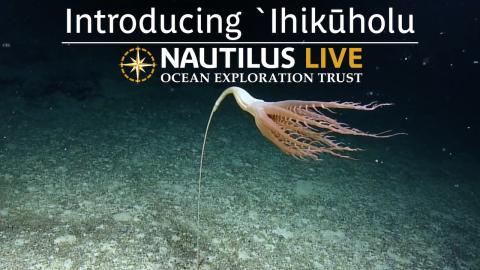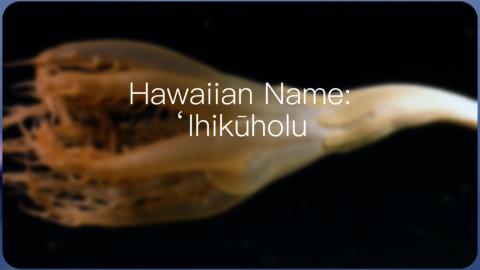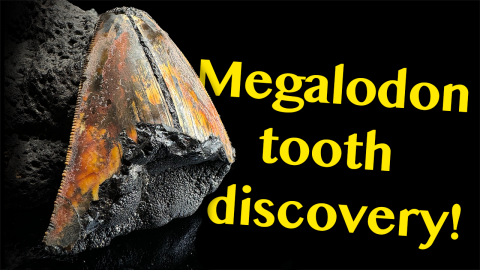New Study Documents First in-situ Discovery of Fossil Megalodon Tooth in Deep Pacific Ocean
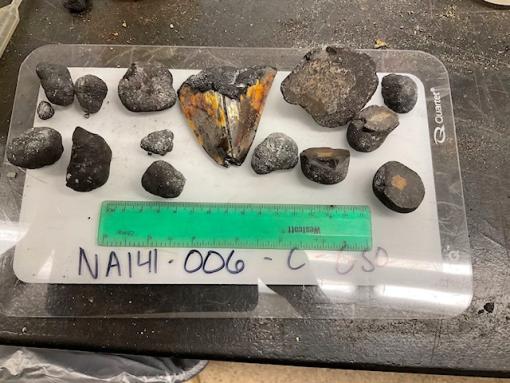
A study* published by Historical Biology last month documents the first in situ discovery of a fossil tooth of the megatooth shark Otodus (Megaselachus) megalodon from the deep sea in the Pacific Ocean. The fossil was collected at a depth of over 10,000 feet (3,090 meters) by remotely operated vehicle (ROV) Hercules on an expedition by Ocean Exploration Trust (OET)’s Exploration Vessel (E/V) Nautilus while exploring a never-before-surveyed seamount ~150 miles south of Johnston Atoll. Commonly known as megalodon, this species was among the largest sharks ever to inhabit our planet but went extinct approximately 3.5 million years ago.
Collected during a three-week expedition that explored previously unsurveyed deep-sea habitats in the Johnston Unit of the Pacific Remote Islands Marine National Monument, the tooth represents the first reported case of an in-situ observation and subsequent sampling of a fossil megalodon tooth in the deep sea. Deep-sea fossils are typically collected by dragging nets on the bottom of the seafloor, a methodology that does not allow scientists to determine the exact sampling location, contextual information that is crucial for scientists to determine how fossils formed and what led to their current state.
“This is an amazing find and is interesting in several aspects,” says Nicolas Straube, Associate Professor at the University Museum Bergen in Norway and co-author of the study. “The fossil was discovered at a very remote deep-sea locality from which megalodon fossils are rarely documented. Further, its partial encapsulation with manganese suggests that fossil shark teeth are an ideal basis for manganese accumulation.”
As is standard practice on E/V Nautilus expeditions, the expedition’s geological samples become publicly accessible resources for researchers worldwide and are shipped to the University of Rhode Island’s Marine Geological Samples Laboratory for cataloging and storage. There, the curatorial team of researchers processing the samples spotted ridged edges, an unusual feature for these types of rocks. After scraping off the ferromanganese coating, the research teams of Dr. Katherine Kelley and Dr. Rebecca Robinson realized they were looking at a shark tooth and speculated that it may have belonged to the megalodon shark.
This identification was confirmed by shark expert Dr. Dave Ebert, President of the American Elasmobranch Society and research faculty at Moss Landing Marine Laboratories, due to its size, shape, and serration patterns.
“This discovery highlights the value of multi-disciplinary collaboration," says Daniel Wagner, OET Chief Scientist and co-author of the study. "Geologists, biologists, paleontologists, and experts in other disciplines all worked together as part of this study, which included important contributions from experts representing eight different institutions in four different countries. By working together, we can learn so much more about our largely unexplored ocean."
Fossilized megalodon teeth are commonly found near shorelines where fossil beds are exposed to wave action or rivers. The majority of findings occur in locations that are easily accessible from land, while the deep sea remains largely unexplored. Ferromanganese is a black mineral deposit that precipitates extremely slowly from seawater and coats objects found on the deep ocean floor. These mineral deposits form at an average rate of a few millimeters per million years and their thickness can be used to date objects covered by this coating.
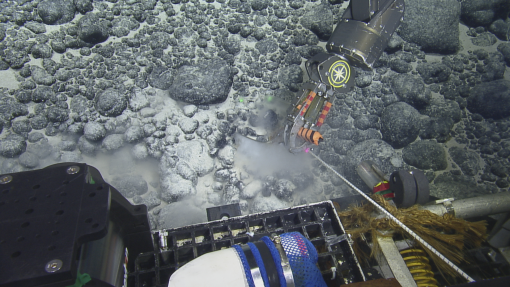
“This fossil provides us with important insights into the distribution of megalodon,” says Jürgen Pollerspöck, researcher at the Bavarian State Collection of Zoology in Germany and co-author of the study. “The sample indicates that megalodon was not a purely coastal species and that this species migrated across ocean basins similar to many modern-day species such as the great white shark.”
Located over 800 miles south of the Hawaiian Islands, Johnston is one of the most remote atolls on Earth. This region is well known for its rich biodiversity, including a high abundance of sharks and other apex predators, which contributed to its designation within the Pacific Remote Islands Marine National Monument in 2009, one of the largest protected areas in the world. Due to its unique biodiversity and geological history, the region has fascinated researchers in many disciplines for a long time, but most of its deep seafloor has never been explored.
The expedition on which the fossil tooth was found was led by Ocean Exploration Trust and funded by NOAA Ocean Exploration via the Ocean Exploration Cooperative Institute. Expedition goals were to explore never-before-surveyed deep-sea habitats around Johnston Atoll and to collect baseline information to support studies on the biodiversity, geological age, and volcanic history of this remote region.
*Jürgen Pollerspöck, Danielle Cares, David A. Ebert, Katherine A. Kelley, Robert Pockalny, Rebecca S. Robinson, Daniel Wagner & Nicolas Straube (2023) First in situ documentation of a fossil tooth of the megatooth shark Otodus (Megaselachus) megalodon from the deep sea in the Pacific Ocean, Historical Biology, DOI: 10.1080/08912963.2023.2291771
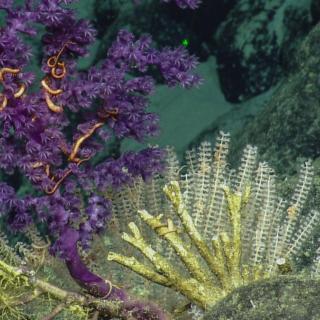
Deep Sea Biodiversity & Ancient Volcanoes near Johnston Atoll
Johnston Atoll, one of the most isolated atolls in the world, is located in the central Pacific Ocean, between the Hawaiian Islands, the Line Islands, and the nation of Kiribati. Around this atoll, the Pacific Remote Island Marine National Monument (PRIMNM) was expanded in 2014 to protect the full 200 nautical mile perimeter of the exclusive economic zone (EEZ) encompassing many unexplored seafloor features.
